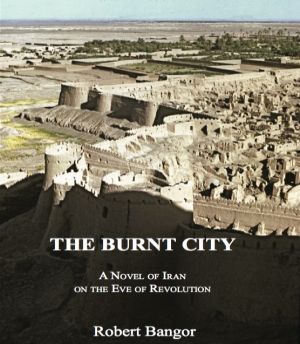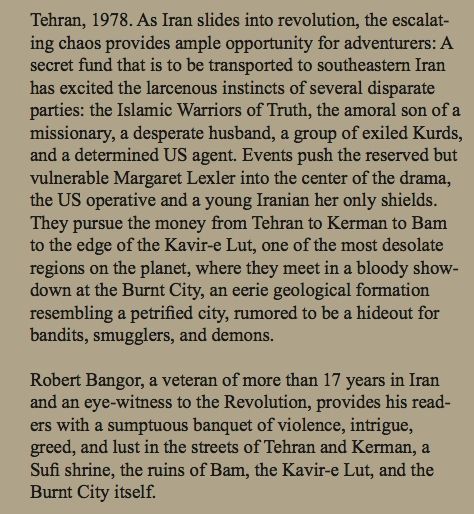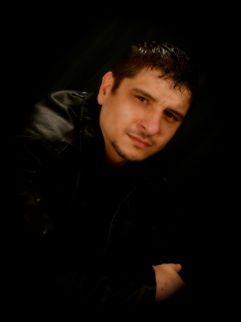
Publisher:
Bonnie King
CONTACT:
Newsroom@Salem-news.com
Advertising:
Adsales@Salem-news.com

~Truth~
~Justice~
~Peace~
TJP
Apr-18-2011 00:04

 TweetFollow @OregonNews
TweetFollow @OregonNews
Robert Bangor Discusses New Book
Interview by Tim King Salem-News.com"...the author spices the adventure with touches of humor, irony, and surprises, plus an adroit manipulation of the characters from crisis to crises" - Agron Belica, author of The Crucifixion: Mistaken Identity?
 |
(SALEM) - Iran is always in the spotlight of American media, but the odds of getting close to the truth via any type of western reportage are more often than not a long shot. That's too bad, because the Middle east is packed with important, captivating history. Robert Bangor's new book, "The Burnt City", explores time and space in this part of the world seemingly far away, yet eternally in our interest.
Dr. Robert Bangor has a Ph.D in Persian literature. The author of the newly published novel, The Burnt City, was an eyewitness to the sweeping change that the people of Iran experienced during the revolution that took place three decades ago. His voice reflects a true picture from one of the world's most ancient societies.
TK: I’m pleased that you accepted my invitation for an interview, Robert. I understand that you are a difficult man to pin down.
RB: I hope it wasn’t that difficult. Actually, I feel honored that you found the publication of a novel about the Iran of three decades ago worthy of notice. I have had occasion in the past to visit your website and have found it consistently provocative and interesting. You and your colleagues seem to be on the side of the underdog when his barking is justified and I find that worthy of admiration.
TK: Thank you. Kind of you to say that. Now let’s turn to the subject at hand: The Burnt City. Why that title?
RB: The Burnt City? The Persian is Shahr-e Sukhteh. The name is used in several places in Iran. There’s a well-known archaeological site by that name near the Afghan border to the east, but that is a mound of real towns, one built on top of another in layers, going back several millenia. The Burnt City of the novel is located on the western side of the Kavir-e Lut—that means “the Naked Desert”—about a hundred miles northeast of the city of Kerman in southeastern Iran. It is not a real city of ruined buildings like Bam, but rather a geological oddity. Incidentally, although I did not know it at the time I wrote the original draft in 1982, there is a similar, but much smaller, formation in New Mexico called the City of Rocks. I saw it when I was touring New Mexico a few years ago. It covers about 40 acres, while the Burnt City of the book is much larger, with an area of about a square mile or so.
 |
TK: Interesting. Your Author’s Note says that you are fluent in Persian and that you lived in Iran for about 17 years, including the years of the ’78-’79 Revolution. Did you actually see any of the events you describe in the book?
RB: Well, most of the historical events I described in my little book—
TK: (laughing) I would hardly describe 500 plus pages as a little book.
 RB: (also laughing) I was speaking in cosmic terms. As I was saying, most of the events occurred around me. I lived not very far from Tehran University where a lot of the action took place. As students formed the feet on the ground of the revolution and I knew several of them, I was able to witness the marches, the chanting, and demonstrations. I was present when the students tore down the statue of the Shah during the revolution. I visited the site of the Black Friday massacre mentioned in the book a few days after the event and saw the bullet holes and troops posted there.
RB: (also laughing) I was speaking in cosmic terms. As I was saying, most of the events occurred around me. I lived not very far from Tehran University where a lot of the action took place. As students formed the feet on the ground of the revolution and I knew several of them, I was able to witness the marches, the chanting, and demonstrations. I was present when the students tore down the statue of the Shah during the revolution. I visited the site of the Black Friday massacre mentioned in the book a few days after the event and saw the bullet holes and troops posted there.
TK: Did you ever find yourself in any personal danger.
RB: I was caught in gunfights three times, as I remember. The last occurred just as a friend and I were exiting a movie theater. We couldn’t tell which direction the bullets were coming from, so we did the obvious thing.
TK: Which was?
RB: We threw ourselves on the pavement next to some parked cars and waited for the shooters to finish their shooting. (laughs)
TK: Makes sense to me. What about the language? How did you acquire that?
RB: Self-study and later, courses at the University. I have done some translation from time to time. In Iran at that time, French was still more widely known than English, so I had to learn Persian to survive. They say that when a man is a fluent in another language, he becomes two men.
TK: Have you ever visited Esfahan? Is it as beautiful as they say?
RB: Iranians, when speaking of Esfahan, say Esfahan, nesf-e jehan. “Esfahan (is) half the world.” Yes, it is. Even more so.
TK: But it doesn’t figure in your book.
RB: No, alas, it does not. But Kerman, which does, has a lot for the visitor to see. The shrine at Mahan is described in the book, as is the abandoned Old City of Bam. When I visited Bam, it looked as it is depicted on the cover of the book: one of the great ruins of the world; like Petra. I have not seen it since the great earthquake of 2003. I don’t see how it could be restored.
TK: Are any of the characters in the book based upon real people?
RB: You mean real people I have known? A few of them may be, but for the most part, they are fictional composites. I have tried to give the reader some idea of their different points of view: Kurds as opposed to Persians, the dedicated Warriors of Truth with their Islamic agenda. In English, the “Warriors of Truth” sounds a bit pretentious, but in Persian—Ghaziyan-e Haqq—is quite serious.
TK: Did you ever meet the Shah or Queen Farah?
RB: No. I did see him in person at least once. He attended a symphonic concert, I think it was—not an opera—at Rudaki Hall and I was seated above him in the balcony about 30 feet away. (chuckles) I recall that he dozed during part of it and I believe the Queen nudged him.
TK: Were you surprised by the revolution?
RB: Not by the revolution itself; just by the speed of its success once it got started. In the years just prior to the revolution, there were a lot of social changes. Religion was becoming fashionable in the middle and upper middle class. Mysticism and Sufism regained their former popularity. At the same time, there was a lot of unrest. We had not yet entered the era of email and the Internet, but we had radio and Persian-language shortwave broadcasts by the BBC, Radio Moscow, and others that attracted huge audiences in Iran, who were rapidly becoming more sophisticated. At the same time, the government was fumbling and making unpopular agreements with the US and its allies in particular. I recall that in the mid ‘70s, foreign truck drivers were brought in to Iran where there was no shortage of local truck drivers. Why? Special arrangements for members of the royal family or its entourage were assumed to be the beneficiaries of the agreement. Many of imported drivers were Korean and the Tehranis used to joke that since their arrival, all the stray dogs of the city had disappeared
TK: Meaning?
RB: Iranians do not eat dog meat, but it was said to be a delicacy in Korea. I might emphasize that all the rumors and gossip mentioned in The Burnt City are authentic. I heard them all, but I of course, I cannot swear to their absolute truth.
TK: As a veteran of the Middle East, how do you compare Iran’s revolution with the current unrest going on there?
RB: Times have changed. Communication has changed. It is too early to say what will have changed for the people until this period is over. One thing I notice is that all of them, even the Egyptian, lack a strong figure about whom the opposition can rally. Iran had Ayatollah Khomeini. He brought about a revolution in Iran in many ways as significant for the Middle East as the French Revolution was for Europe.
TK: It didn’t spark much change in the Arab world.
RB: No, but think of the French Revolution in the late 1790s and then of the much more widespread upheavals of 1848 that were its grandchildren.
TK: Your book ends with a surprise. Will there be a sequel?
RB: (laughing) That depends. In my possession, there is another draft of a novel that I wrote “between jobs,” as it were, in the same period as The Burnt City. It is also about the Iranian Revolution, or rather the events leading up to it—a kind of prequel, although with different characters. As for the sequel, it is too early to tell, but, “After all… tomorrow is another day”
TK: (laughs) That sounds familiar. I look forward to seeing your book in bookstores. By the way, how can someone get a copy of The Burnt City? Where is it available?
RB: It can be ordered at the Harvard Book Store, 1256 Massachusetts Avenue, Cambridge, MA 02138. Permit me to take this opportunity to thank Brad Lennon and his team for their excellent work on the book. Brad also did the cover design, which all who have seen it admire. I only hope that they can get past it to read the book itself.
TK (laughs) Thank you very much, Robert Bangor. The book is The Burnt City and it’s available at the link below.
RB: My pleasure.
Editor’s Review:

The Burnt City, by Robert Bangor, gives the reader a different slant on the Islamic revolution in Iran in 1978-79. Against a background of marches, strikes, and violence, several groups and individuals are in pursuit of loot, not political change—at least not until they get their hands on the loot. The characters are sharply drawn and represent not only West and East, but also class struggle, conflicting aspirations, pure greed, and even innocence.
The Warriors of Truth, who open the book with a bank robbery, vie with Kurds, SAVAK, a US CIA contractor, and several individuals for the prize. The action moves them from Tehran to southeastern Iran with one of the most forbidding places on the planet: the Kavir-e Lut—the Naked Desert. Their journeys end at the Burnt City at its edge.
If the action is not enough, the author spices the adventure with touches of humor, irony, and surprises, plus an adroit manipulation of the characters from crisis to crises. As the story develops, the focus moves to the machinations of the CIA contractor, Mitchell Ritchie, and to the “new” woman, Margaret Lexler, who is unwillingly caught up in the avarice of others. Plot twists and cliffhangers abound, but the tale is not without pathos and introspective moments of considerable beauty.
Robert Bangor formerly lived in Iran and witnessed the Revolution and the return of Ayatollah Khomeini. He is fluent in Persian and a knowledgeable observer of Muslim culture, especially that of Iran. His book sparkles with authenticity and keen observation.
I found The Burnt City very entertaining. I enjoyed the character sketches and the variety of the story. Just when I thought I had it figured out, the author turns the tables on the reader. I can heartily recommend it to anyone who likes adventure spiced with a little greed and lust in exotic settings, and does not mind learning something about Iran and Iranians in a pleasurable way. In short, reading it is a good way to spend a few hours of your leisure.
Agron Belica, author of The Crucifixion: Mistaken Identity?
http://www.harvard.com/book/the_burnt_city_a_novel_of_iran_on_the_eve_of_revolution/
_________________________________________________________Tim King: Salem-News.com Editor and Writer
Tim King has more than twenty years of experience on the west coast as a television news producer, photojournalist, reporter and assignment editor. In addition to his role as a war correspondent, this Los Angeles native serves as Salem-News.com's Executive News Editor. Tim spent the winter of 2006/07 covering the war in Afghanistan, and he was in Iraq over the summer of 2008, reporting from the war while embedded with both the U.S. Army and the Marines. Tim is a former U.S. Marine.
Tim holds awards for reporting, photography, writing and editing, including the Silver Spoke Award by the National Coalition of Motorcyclists (2011), Excellence in Journalism Award by the Oregon Confederation of Motorcycle Clubs (2010), Oregon AP Award for Spot News Photographer of the Year (2004), First-place Electronic Media Award in Spot News, Las Vegas, (1998), Oregon AP Cooperation Award (1991); and several others including the 2005 Red Cross Good Neighborhood Award for reporting. Tim has several years of experience in network affiliate news TV stations, having worked as a reporter and photographer at NBC, ABC and FOX stations in Arizona, Nevada and Oregon. Tim was a member of the National Press Photographer's Association for several years and is a current member of the Orange County Press Club.
Serving the community in very real terms, Salem-News.com is the nation's only truly independent high traffic news Website. As News Editor, Tim among other things, is responsible for publishing the original content of 91 Salem-News.com writers. He reminds viewers that emails are easily missed and urges those trying to reach him, to please send a second email if the first goes unanswered. You can write to Tim at this address: newsroom@salem-news.com
Articles for April 17, 2011 | Articles for April 18, 2011 | Articles for April 19, 2011

Salem-News.com:
googlec507860f6901db00.html



Terms of Service | Privacy Policy
All comments and messages are approved by people and self promotional links or unacceptable comments are denied.
Nellie April 18, 2011 6:12 am (Pacific time)
Thanks so much for this interview. I look forward to reading the book.
[Return to Top]©2025 Salem-News.com. All opinions expressed in this article are those of the author and do not necessarily reflect those of Salem-News.com.